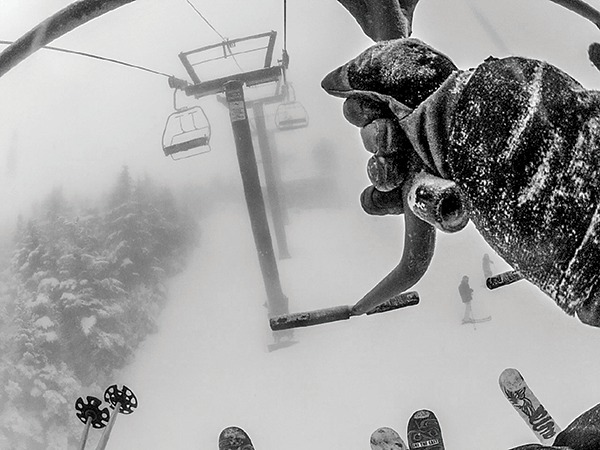The art and science behind calling a wind-hold.
Skiers and riders are a bit like surfers in their reaction to storms, which is in stark contrast to the general public’s. When a hurricane approaches, many people take cover in a windowless basement, while surfers strap boards to cars and head for the open seas. Similarly, when a winter storm nears, skiers and riders leave the madhouse grocery shopping and hunkering down to everyone else while they pack their gear and point their four-wheel-drive up the mountain road.
Sometimes, though, the welcome snow arrives with wind, its not-so-welcome partner. And our expectations for the perfect ski day are dimmed. What is the big deal about high winds, when do we have to worry that our powder day may be compromised, and why did the 2012–13 ski season seem so much windier than others?
John Hammond, Sugarbush’s vice president of mountain operations and recreational services, would say that wind is a very big deal. Overseeing ski patrol and lift operations, among other things, Hammond is ultimately responsible for maintaining safety on the mountain … for everyone. It’s kind of a big responsibility, and one he doesn’t take lightly. And high winds are one of the things Hammond worries about the most. Winds can affect us in several ways, by causing problems for people getting off a chair, by impacting the ability of high-speed detachable chairs to go around the terminal, by causing the lift line to oscillate, by pushing chairs into towers, and, the worst-case scenario, by causing the lift line to derope. Hammond doesn’t even like to say the word “deropement”—when the lift line jumps the track and falls, dropping chairs to the ground. While deropement is an uncommon occurrence, it has happened in the Northeast in recent years, though luckily not at Sugarbush.
“As wind approaches 40 miles per hour, we’re concerned,” says Hammond, sitting in Sugarbush’s mountain operations office. “When it goes above 40 mph, we’ll post mechanics at the tops of the lifts to watch how the lift and the wind interact.”
A 40 mph wind exerts 4 pounds of force on every 1 square foot of surface. As the speed of the wind increases, its force grows exponentially, so that a 60 mph wind exerts a force double that of a 40 mph wind.
The force of the wind is critical, but wind direction is just as important. A strong wind blowing straight up the line may allow a lift to continue running at normal speed, while a strong wind blowing across the line may exert a sideways force on the chairs, causing dangerous lateral deflection. Additionally, winds are often inconsistent, so the wind at the base of a lift may be tolerable, while the wind at the summit may be gusting significantly.
When performing a wind check, Hammond’s team is looking for lateral deflection in the chairs measuring 15 degrees or more. The team is also looking to see if the chairs can travel smoothly around the bull wheel. A detachable chair typically travels at a speed of 11 mph. If there is a chance to mitigate the wind’s impact on the chair by slowing its speed, the operator will do so. But if slowing the lift does not change the impact, “wind-hold” is called: Dispatchers radio to the lift operator to call “last chair,” all remaining skiers and riders already on chairs are delivered to the top of the lift, and the lift is stopped. The lift is then put on watch and monitored for changes that may allow it to reopen.
Tony Vazzano of North Winds Weather in New Hampshire has been supplying Sugarbush’s weather reports for thirty years. Vazzano’s report is often the first indicator to Hammond of an approaching wind and its strength and direction. “When we get a big snowstorm [at Sugarbush], often there are big northwest winds behind it,” says Vazzano. “And a nor’easter brings with it a wind from the East that blows for much of the duration of the storm.”
At Sugarbush, lifts are constructed at varying aspects of the mountains, allowing for some to stay open in high winds when others may close. Typically, the good places to ski on windy days are the lifts that are protected by trees or situated low to the ground. At Sugarbush, this includes Gate House Express and Castlerock at Lincoln Peak, and the Sunny Double and Inverness at Mt. Ellen.
The good news is that skiers and riders don’t have to worry, because Hammond and his team do the worrying for us. Hammond may be aggressive in other areas of his job, like snowmaking and grooming, but wind safety is one area where he is ultraconservative. “This is not an exact science, but we want to be on the side of guest safety and equipment safety. We’re not going to push the limits on this.” Makes sense to me. Maybe I won’t be so upset next time Heaven’s Gate goes on wind-hold.
And as for the perception that the 2012–13 season was windier than usual? Wind-hold hours did measure above average at Sugarbush. In recent years, the last season that tracked more wind-hold hours was the winter of 2008–09. But when thinking about the weather, Tony Vazzano takes more of the long view. In the 2011–12 season, he says, “There was no winter, and there was almost no wind. This past year was just more typical.” Okay. I’ll take another typical year with 279 inches, and a little wind along with all the snow.

